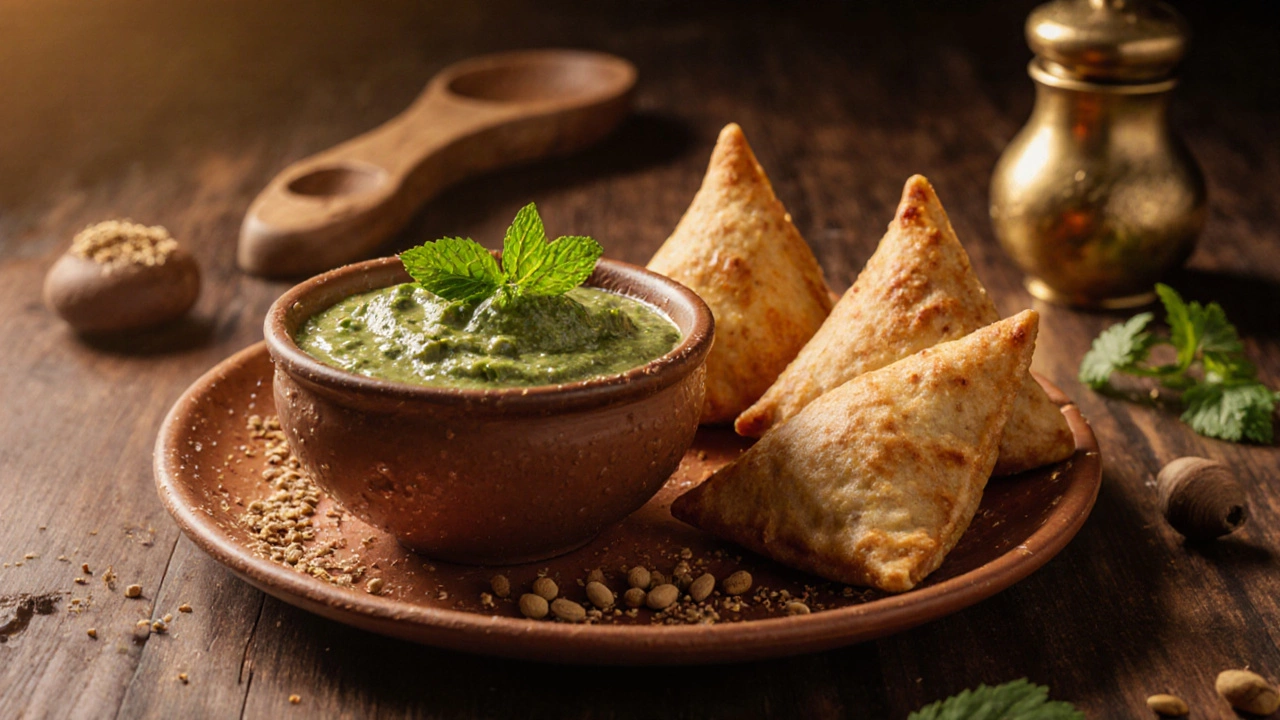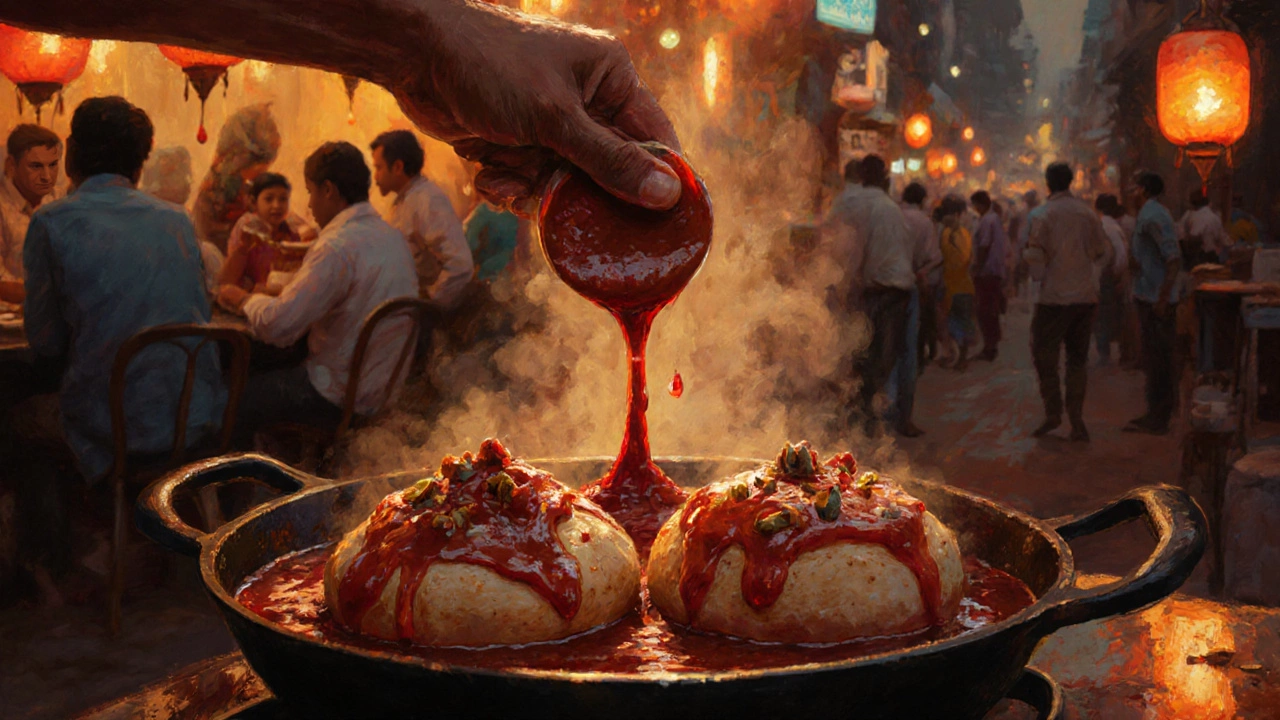Should Chutney Be Served Warm or Cold? The Real Answer from Indian Kitchens
 Nov, 18 2025
Nov, 18 2025
Chutney Temperature Advisor
Recommended Serving Temperature
When you take a bite of a crispy samosa or a fluffy dosa, the chutney on the side can make or break the whole experience. But here’s the question no one talks about: should chutney be served warm or cold? It’s not just a matter of preference-it’s about flavor, texture, and tradition. And the answer isn’t the same for every kind of chutney.
Not All Chutneys Are Created Equal
Chutney isn’t one thing. It’s a whole family of condiments. A fresh coriander chutney made with lemon, green chilies, and cilantro is completely different from a slow-cooked tamarind chutney simmered with jaggery and spices. How you serve it depends on how it’s made.
Herb-based chutneys-like mint, coriander, or coconut-lose their brightness when heated. The oils in the herbs break down, the color dulls, and the sharpness fades. These are meant to be served cold, straight from the fridge or at room temperature. Think of them like salsa or pesto: their job is to cut through richness with freshness.
On the other hand, cooked chutneys-like tamarind, mango, or onion-based ones-develop deeper flavors when warmed. The sugars caramelize, the spices bloom, and the vinegar mellows. A warm tamarind chutney clings to a samosa better. It’s sticky, sweet, and tangy in a way that feels comforting, not just sharp.
The Science Behind the Temperature
Temperature changes how your taste buds work. Cold dulls sweetness and enhances acidity. That’s why a cold mint chutney tastes more zingy than the same one at room temperature. Warmth, on the other hand, unlocks aromas. Volatile compounds in spices like cumin, mustard, and fenugreek become more active when heated. That’s why a warm onion chutney smells richer and fills the air.
Texture matters too. Cold chutneys are thicker, almost paste-like. Warm ones thin out slightly, becoming more pourable. That’s why you’ll see street vendors in Mumbai drizzling warm tamarind chutney over pav bhaji-it flows just right. But if you try to warm a fresh coriander chutney, it turns watery and loses its grip.
Studies on flavor perception show that the human tongue detects sour and bitter notes more strongly at lower temperatures, while sweetness and umami are more pronounced when food is warm. That’s why a cold coconut chutney feels tangy and refreshing, while a warm date chutney tastes like a sweet-sour hug.
Regional Traditions Tell the Real Story
Ask a grandmother in Chennai, and she’ll tell you: mint chutney is always cold. Ask someone in Lucknow, and they’ll say tamarind chutney should be warm with the pakora. These aren’t random habits-they’re rooted in centuries of practice.
In South India, coconut chutney is served at room temperature with idli and dosa. It’s made fresh daily and never reheated. In North India, aam chutney (mango chutney) is often cooked slowly with sugar and spices, then stored in jars. It’s served at room temperature or gently warmed, especially in winter.
Even in Bengal, the famous panch phoron chutney is served warm with fish dishes. The spices-fenugreek, cumin, nigella, mustard, and fennel-are toasted and ground, then simmered in oil. Heat unlocks their full aroma. Serve it cold, and you miss half the point.

What About Store-Bought Chutney?
If you’re using bottled chutney, the rules change slightly. Most commercial brands are pasteurized and designed to be shelf-stable. They often contain preservatives and added vinegar that can taste harsh when cold.
Try this: take a spoonful of store-bought tamarind chutney and warm it gently in a pan for 30 seconds. Stir in a pinch of sugar if it’s too sour. You’ll notice the flavor opens up-less artificial, more rounded. Same goes for tomato chutney. Cold, it’s flat. Warm, it’s alive.
But don’t heat bottled mint or coriander chutney. It’ll turn bitter and smell like wet grass. Stick to room temperature for those.
When to Warm Chutney
Warm chutney works best with:
- Pakoras or samosas-the heat helps the chutney cling to the fried exterior
- Pav bhaji or chaat-warm chutney blends with the spices and softens the texture
- Grilled meats or roasted vegetables-especially with mango or date chutney
- Winter meals-a warm chutney adds comfort when the air is cool

When to Keep Chutney Cold
Cold chutney shines with:
- Idli and dosa-the coolness balances the fermented rice batter
- Plain rice or curd rice-it adds a refreshing contrast
- Spicy curries like vindaloo or jalfrezi-cold chutney cools the heat
- Summer snacks-fresh herb chutneys are hydrating and light
Pro Tip: Temperature Matters Even When You’re Not Cooking
Let’s say you made a big batch of coconut chutney on Sunday. You put it in the fridge. On Wednesday, you take it out and serve it straight from the fridge. It’s too cold. The flavors are locked in.
Take it out 20 minutes before serving. Let it sit on the counter. It doesn’t need to be warm-just not icy. Same with tamarind chutney: if it’s been sitting in the fridge, warm it gently for 15 seconds in the microwave. Stir well. That’s all it takes.
Don’t microwave herb chutneys. They’ll turn muddy. Use a bowl of warm water instead. Place the jar in it for 5 minutes. Slow, gentle warming preserves the flavor.
The Bottom Line
There’s no single rule. It’s about matching the chutney to the food and the moment. Cold chutneys are for freshness. Warm chutneys are for depth. One isn’t better than the other-they’re different tools.
If you’re serving a plate of hot, spicy dosas, a cold mint chutney is your best friend. If you’re eating a plate of warm, crispy pakoras, a gently heated tamarind chutney will make you close your eyes and smile.
Next time you make chutney, ask yourself: Is this meant to wake up your taste buds or wrap them in warmth? The answer tells you exactly how to serve it.
Can I reheat chutney in the microwave?
Yes, but only for cooked chutneys like tamarind, mango, or onion. Heat for 10-15 seconds on low power, stir, then check. Never microwave fresh herb chutneys like mint or coriander-they’ll turn bitter and lose their color. Use a warm water bath instead for those.
Why does my chutney separate when I warm it?
Separation happens when oils and water-based ingredients aren’t fully blended. This is normal in homemade chutneys with coconut, nuts, or oil. Stir it well before serving. If it’s too thin, let it sit for 10 minutes-it’ll thicken as it cools slightly. Adding a pinch of roasted cumin powder can also help bind it.
Should I serve chutney at room temperature or straight from the fridge?
For herb-based chutneys, room temperature is ideal. Cold from the fridge dulls the flavor. Take it out 15-20 minutes before serving. For cooked chutneys, room temperature is fine, but gently warming them enhances the aroma. It’s not necessary, but it makes a difference.
Does chutney spoil faster if served warm?
If you’re serving chutney at a party and leaving it out for hours, yes-especially fresh ones. Always keep herb chutneys refrigerated until serving. Cooked chutneys with sugar and vinegar last longer at room temperature, but still shouldn’t sit out for more than 4 hours. When in doubt, refrigerate and re-warm as needed.
Can I freeze chutney?
Yes, but only cooked chutneys freeze well-tamarind, mango, date. Freeze in small portions. Thaw overnight in the fridge. Reheat gently before serving. Herb chutneys don’t freeze well-the texture turns mushy and the flavor fades. Make them fresh instead.
